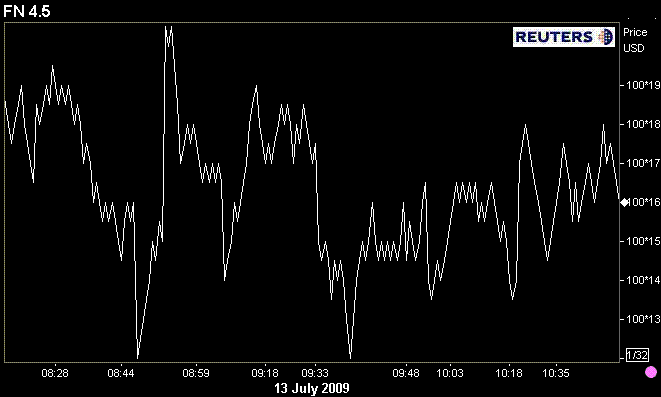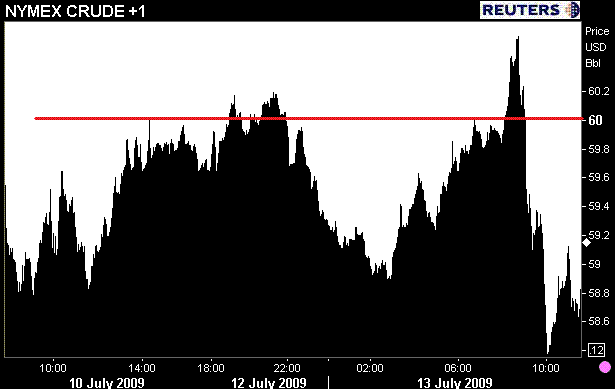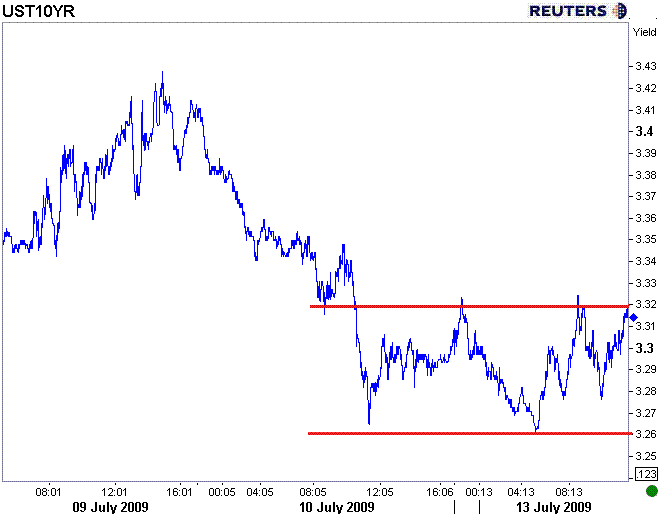Talk about the definition of summer slumber! Everything is sloooow this morning...including me. I cant seem to wake up!
The FN 4.5 was choppy early on in the session, but has since found a range and is now taking directional guidance from the gyrations of the yield curve (and swaps).

In the MBS market, trading volume is light with the only noticeable signs of activity coming from originators looking to lock in rates by selling MBS. This "locking in" is being done to protect pipeline profits from interest rate risk. Remember the MBS coupons that determine your rate sheet pricing are traded in the TBA MBS market...TBA = To be Announced. In the TBA market, at the time of a trade, buyers and seller agree to only a few specific terms, like what coupon, the issuing agency (Fannie or Freddie), and a buy/sell (bid/ask) price....the actual pools of loans that will be bought and sold are not disclosed at the time of this agreement
The TBA trading mechanism plays a very important role in the generation of mortgage rates. The TBA market allows originators to make "forward commitments" before the loans in their pipeline are actually closed...just like loan officers lock in interest rates before the loan goes to closing. For both the mortgage bank and the loan officer, this function serves as a hedge. It allows them to protect their pipelines from interest rate risk (rates getting higher and their loans not being worth as much). If mortgage bankers were forced to lock in their rates after closing...they would likely add in a large "interest rate risk" premium to rate sheets in an effort to protect themselves from shifts in the yield curve.
This would explain why we have seen some choppy price action thus far this morning. When trading volume is light and demand for "rate sheet influential" MBS coupons is weak...excess supply of current coupon MBS will not be met with enough demade to keep current market prices stable....instead prices must fall to offset excess supply (to raise demand). This is where the Federal Reserve comes into play...this morning we have seen this occurring as the Fed is providing demand side support...helping to restore liquidity to the marketplace.
Why No Demand for "Rate Sheet Influential" MBS?
Last week we witnessed most of the accounts that needed to buy "rate sheet influential MBS"...buying last week, so portfolios are likely already hedged, removing the need for further positioning until the yield curve moves out of its recent range. These buyers are the convexity crowd...mostly servicers hedging the duration of their liabilities to the duration of their assets. What about everyone else? The remainder of accounts are to moving "up in coupon"...
What is Up in Coupon????
Each month MBS analysts and traders spend a considerable amount of time forecasting borrower refinance behavior. Borrower refinance behavior (or anything that associate with paying off your mortgage) is revealed through MBS portfolio prepayment speeds. Prepayment speeds are the key determinant in the valuation function of MBS.
When rates are expected to be lower in the future, well I should say low enough to provide incentive to refinance or purchase, the pools of mortgages (MBS) that are backed by loans with higher rates will begin to lose more and more value as rates go lower and more borrowers refinance their loans (they prepay their loan or use their call option). Remember the income MBS investor expect to receive is generated when you pay your monthly payment, so if you refinance your loan MBS investors lose the income stream they were expecting you to contribute to the MBS pool. MBS investors therefore must find a way to replace that lost expected future cash flow. If a group of MBS investors believes rates will go lower then they may sell a portion of their higher interest rate (fuller) MBS portfolio in favor of lower rate pools to compensate for lost income (and need to extend duration of their cash flows if yield curve is flattening). They do so because they believe they will receive stable cash flows for a longer period of time (relative to liabilities..that is the investor must offset cash inflow duration with cash outflow duration). This translates into either buying “up in coupon” or buying “down in coupon” (selling too) which consequentially implies better or worse mortgage rates for you.
Recently, MBS buyers have been doing more buying " up in coupon" because of a lack of prepayment risk due to the fact that borrowers currently face a considerable amount of roadblocks in the refinance process. These barriers include loss of equity, inability to qualify as lender underwriting has tightened, higher mortgage rates, a lack of funding in mortgage market, HVCC, long turn times, etc, etc,etc. This "up in coupon" bias has left demand for "rate sheet influential" MBS coupons in the hands of a very specific crowd....servicers, real money buyers like banks and insurance companies, and the biggest demand side supporter:The Federal Reserve!
In order for the "up in coupon" bias to go away...the previously discussed roadblocks to recovery need to be alleviated. Guess who would know best about the prospects for that happening....loan officers and borrowers!
Anyway lesson over...
Equity indices are at intraday highs after Meredith Whitney said bank earnings would be bolstered by strong trading profits, however volume is very low, signaling no strength to the rally. That said the S&P is being led higher by financial stocks...

For a better indicator of economic outlooks...oil prices cant hold gains over $60...STILL.

And the yield curve is in waiting mode, hovering near Friday's closing levels. Volume is low in the fixed income market too...I see 275K 10 yr TSY contracts traded thus far.

2s vs. 5s: 133bps
2s vs. 10s: 242bps
5s vs. 10s: 109bps
Not much progress is expected to be made in any market....the range will moderate until new guidance is offered by earnings reports. Question: do strong trading profits imply stable core earnings for banks? Or must one dig deeper into earnings reports for a better indication of earnings to come?
Mortgage rates are slightly higher from Friday as lenders await CONFIRMATION....(fall out risk high plus funding issues (pipeline control) is inhibiting a tightening of primary/secondary spreads (lenders not passing through MBS market gains to borrowers).





